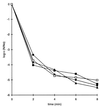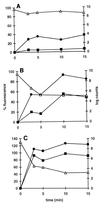Variation in resistance of natural isolates of Escherichia coli O157 to high hydrostatic pressure, mild heat, and other stresses
- PMID: 10103251
- PMCID: PMC91221
- DOI: 10.1128/AEM.65.4.1564-1569.1999
Variation in resistance of natural isolates of Escherichia coli O157 to high hydrostatic pressure, mild heat, and other stresses
Abstract
Strains of Escherichia coli O157 isolated from patients with clinical cases of food-borne illness and other sources exhibited wide differences in resistance to high hydrostatic pressure. The most pressure-resistant strains were also more resistant to mild heat than other strains. Strain C9490, a representative pressure-resistant strain, was also more resistant to acid, oxidative, and osmotic stresses than the pressure-sensitive strain NCTC 12079. Most of these differences in resistance were observed only in stationary-phase cells, the only exception being acid resistance, where differences were also apparent in the exponential phase. Membrane damage in pressure-treated cells was revealed by increased uptake of the fluorescent dyes ethidium bromide and propidium iodide. When strains were exposed to the same pressure for different lengths of time, the pressure-sensitive strains took up stain sooner than the more resistant strain, which suggested that the differences in resistance may be related to susceptibility to membrane damage. Our results emphasize the importance of including stress-resistant strains of E. coli O157 when the efficacy of a novel or mild food preservation treatment is tested.
Figures







References
-
- Archer D L. Preservation microbiology and safety: evidence that stress enhances virulence and triggers adaptive mutations. Trends Food Sci Technol. 1996;7:91–95.
-
- Armstrong G L, Hollingsworth J, Morris J G. Emerging foodborne pathogens—Escherichia coli O157-H7 as a model of entry of a new pathogen into the food-supply of the developed world. Epidemiol Rev. 1996;18:29–51. - PubMed
-
- Arroyo G, Sanz P D, Préstamo G. Effect of high pressure on the reduction of microbial populations in vegetables. J Appl Microbiol. 1997;82:735–742. - PubMed
-
- Bartlett D H. Microbial life at high pressures. Sci Prog. 1992;76:479–496. - PubMed
Publication types
MeSH terms
Substances
LinkOut - more resources
Full Text Sources
Medical
Molecular Biology Databases

